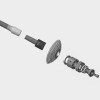Approach routes in hip prosthetic surgery
- Home
- Hip Surgery
- Hip prosthesis
- Approach routes in hip prosthetic surgery
APPROACH WAYS IN HIP PROSTHETIC SURGERY
One of the determining factors in the placement of a hip prosthesis is the approach or “the area” through which the joint is accessed. In general, each traumatologist is accustomed and “comfortable” with specific approaches in hip prosthetic surgery, which are usually determined by what he learned during his training.
Each approach has its advantages and disadvantages. In this section we detail them so that the patient has a global idea prior to the placement of their hip prosthesis.
Why choose a specific approach route
The reasons that make a traumatologist expert in hip surgery choose one approach or another are the following:
- Stability of the prosthesis: Certain accesses have a greater risk than others of producing a “hip dislocation” (the hip “pops out of place”) in the postoperative period than others.
- Muscle damage: The less the muscle is damaged during the placement of the prosthesis, the faster the recovery and the better the function with less limping when walking, playing sports, etc.
- Placement of the prosthesis: The prosthesis must be placed in an appropriate position to avoid early failure. An approach with which the orthopedic surgeon is not comfortable has a higher risk of intra- and postoperative failures.
Types of hip prosthesis approach
A) Posterior approach
- Access to the hip is done after cutting the rotator muscles.
- By leaving the gluteal muscles intact, there is less risk of lameness.
- It allows surgeries of all types, from a primary prosthesis to a complex revision with a significant acetabular defect.
- Its greatest disadvantage is that it is the approach with the highest dislocation rate of all.
B) Lateral approach
- Access to the hip is done after sectioning the gluteus medius muscle.
- It allows easy access to the acetabulum, making it easy to place the cup and reducing the risk of dislocation.
- By damaging the gluteus muscle, there is a greater risk of Trendelenburg (lameness).
C) Previous approach
- It is the “fashionable” approach. Access is made between muscular planes, without cutting any.
- Its greatest advantage is that by not injuring any muscle, there is less postoperative pain and a faster recovery.
- The dislocation rate is very low, as is the risk of postoperative lameness.
- As drawbacks, there is a considerable risk of injury to the femoralcutaneous nerve, which can permanently cause tingling in the anterior thigh. Its learning curve is long, and there is a greater risk of perioperative complications such as femur fractures, poor positioning of a component, etc. The scar is more annoying and visible, which has its importance on an aesthetic level.
D) Anterolateral approach
- It is the author's preferred access. The hip is reached by sectioning less than 20% of the gluteus medius muscle.
- It combines the advantages of the anterior and lateral approach (rapid recovery, less risk of lameness, good muscle function, less bleeding) and avoids the risks of the other approaches in terms of dislocation, perioperative complications, poor implantation of the components, etc.
Conclusions
Scientific literature tells us that there is no approach that is clearly superior to another. All of them have their advantages and disadvantages.
Any access can obtain a great result if the responsible traumatologist has sufficient surgical skill and experience. In my particular case, I must say that I have practiced all types of approaches. Currently, I use the anterolateral approach more frequently due to the patient's rapid recovery and better functional results.
I use the posterior approach for complex revision cases because of its better access to the femur and acetabulum.
Contact Dr. Óscar Tendero in Mallorca and find out how he can help you with hip replacement surgery.
YOUR HEALTH FIRST

GEIS bone tumor meeting

Endo-exo integrated femoral prosthesis
CONSULT
Hospital Juaneda Miramar
Camí de la Vileta, 30
07011 Palma
971 280 000


